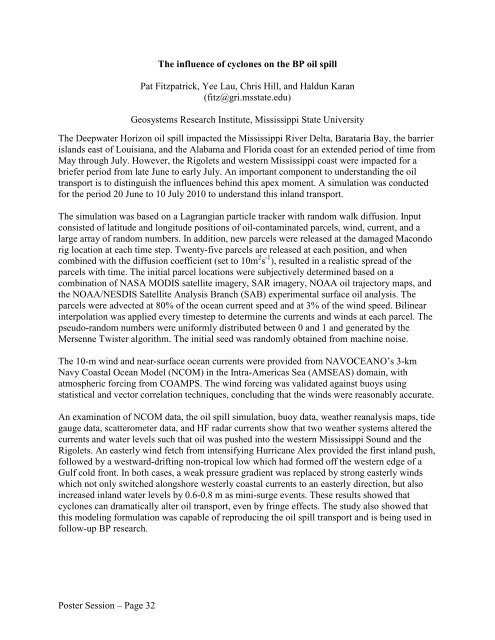65th IHC Booklet/Program (pdf - 4.9MB) - Office of the Federal ...
65th IHC Booklet/Program (pdf - 4.9MB) - Office of the Federal ...
65th IHC Booklet/Program (pdf - 4.9MB) - Office of the Federal ...
Create successful ePaper yourself
Turn your PDF publications into a flip-book with our unique Google optimized e-Paper software.
The influence <strong>of</strong> cyclones on <strong>the</strong> BP oil spill<br />
Pat Fitzpatrick, Yee Lau, Chris Hill, and Haldun Karan<br />
(fitz@gri.msstate.edu)<br />
Geosystems Research Institute, Mississippi State University<br />
The Deepwater Horizon oil spill impacted <strong>the</strong> Mississippi River Delta, Barataria Bay, <strong>the</strong> barrier<br />
islands east <strong>of</strong> Louisiana, and <strong>the</strong> Alabama and Florida coast for an extended period <strong>of</strong> time from<br />
May through July. However, <strong>the</strong> Rigolets and western Mississippi coast were impacted for a<br />
briefer period from late June to early July. An important component to understanding <strong>the</strong> oil<br />
transport is to distinguish <strong>the</strong> influences behind this apex moment. A simulation was conducted<br />
for <strong>the</strong> period 20 June to 10 July 2010 to understand this inland transport.<br />
The simulation was based on a Lagrangian particle tracker with random walk diffusion. Input<br />
consisted <strong>of</strong> latitude and longitude positions <strong>of</strong> oil-contaminated parcels, wind, current, and a<br />
large array <strong>of</strong> random numbers. In addition, new parcels were released at <strong>the</strong> damaged Macondo<br />
rig location at each time step. Twenty-five parcels are released at each position, and when<br />
combined with <strong>the</strong> diffusion coefficient (set to 10m 2 s -1 ), resulted in a realistic spread <strong>of</strong> <strong>the</strong><br />
parcels with time. The initial parcel locations were subjectively determined based on a<br />
combination <strong>of</strong> NASA MODIS satellite imagery, SAR imagery, NOAA oil trajectory maps, and<br />
<strong>the</strong> NOAA/NESDIS Satellite Analysis Branch (SAB) experimental surface oil analysis. The<br />
parcels were advected at 80% <strong>of</strong> <strong>the</strong> ocean current speed and at 3% <strong>of</strong> <strong>the</strong> wind speed. Bilinear<br />
interpolation was applied every timestep to determine <strong>the</strong> currents and winds at each parcel. The<br />
pseudo-random numbers were uniformly distributed between 0 and 1 and generated by <strong>the</strong><br />
Mersenne Twister algorithm. The initial seed was randomly obtained from machine noise.<br />
The 10-m wind and near-surface ocean currents were provided from NAVOCEANO’s 3-km<br />
Navy Coastal Ocean Model (NCOM) in <strong>the</strong> Intra-Americas Sea (AMSEAS) domain, with<br />
atmospheric forcing from COAMPS. The wind forcing was validated against buoys using<br />
statistical and vector correlation techniques, concluding that <strong>the</strong> winds were reasonably accurate.<br />
An examination <strong>of</strong> NCOM data, <strong>the</strong> oil spill simulation, buoy data, wea<strong>the</strong>r reanalysis maps, tide<br />
gauge data, scatterometer data, and HF radar currents show that two wea<strong>the</strong>r systems altered <strong>the</strong><br />
currents and water levels such that oil was pushed into <strong>the</strong> western Mississippi Sound and <strong>the</strong><br />
Rigolets. An easterly wind fetch from intensifying Hurricane Alex provided <strong>the</strong> first inland push,<br />
followed by a westward-drifting non-tropical low which had formed <strong>of</strong>f <strong>the</strong> western edge <strong>of</strong> a<br />
Gulf cold front. In both cases, a weak pressure gradient was replaced by strong easterly winds<br />
which not only switched alongshore westerly coastal currents to an easterly direction, but also<br />
increased inland water levels by 0.6-0.8 m as mini-surge events. These results showed that<br />
cyclones can dramatically alter oil transport, even by fringe effects. The study also showed that<br />
this modeling formulation was capable <strong>of</strong> reproducing <strong>the</strong> oil spill transport and is being used in<br />
follow-up BP research.<br />
Poster Session – Page 32
















